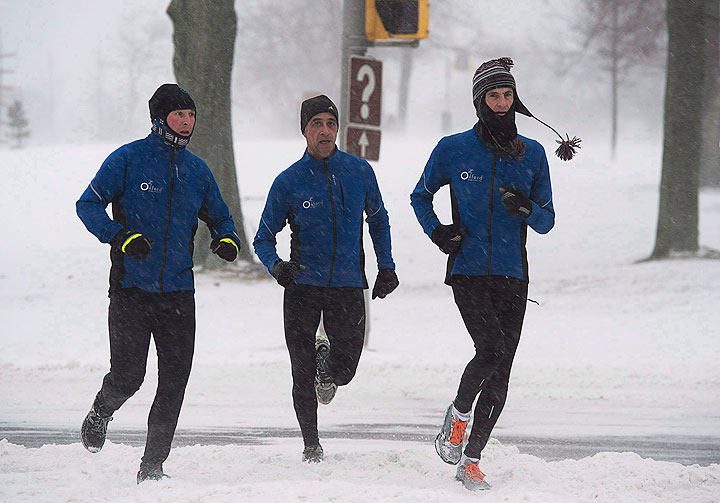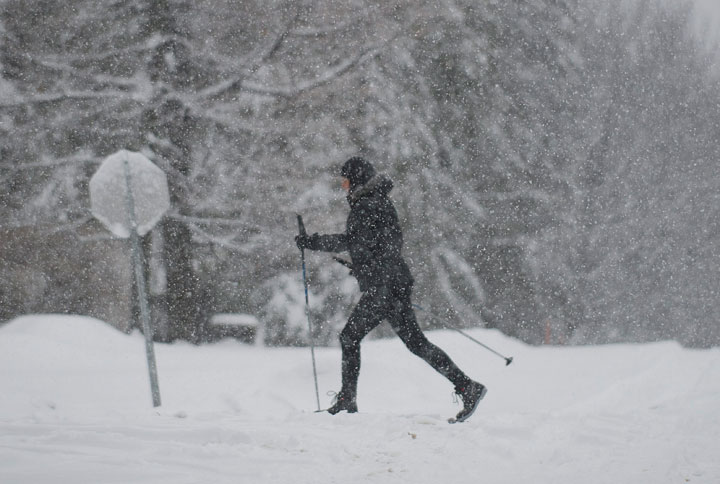TORONTO – As temperatures drop, even the most seasoned outdoor fitness junkies can get discouraged when it comes to working out outside.

While those with health concerns such as heart conditions or respiratory illnesses should consult a physician before proceeding, understanding cold temperatures and preparing ahead of time are key factors in ensuring your outdoor workouts are safe and even enjoyable.
Set yourself up for success but be realistic
Kathleen Trotter, a Toronto-based professional fitness consultant for over 12 years, said before you create a fitness plan, be mindful of your age and abilities.
“Create realistic goals that take into account current and past health history, body style, genetics, age and the time you can commit to it,” she said. “Establish your goals and see what works for you.”
Trotter said it’s also important to avoid creating goals that you know you won’t be able to achieve.
“Don’t have a goal of walking for an hour a day in the winter if you aren’t going to it,” she said. “If you don’t have time after work to work out, don’t say you will work out after work.”
Fitness consultant Jason Gee said before you head out to exercise in the cold weather, start slow.
“Your body takes a bit longer to warm up in the cold,” he said. “Provide yourself at least 10 more minutes of warm up time before you head out in order to elevate your heart rate and warm up your muscles.”
Dress for the weather
Covering your skin and dressing warmly is essential to ensuring your outdoor workout is comfortable and pleasant.
“Proper ventilated gloves, face protection and warm clothing can make a huge difference,” said Gee.
Dr. Stephen Cheung, Canada Research Chair in Environmental Ergonomics at Brock University, said people should wear fabric that removes sweat and moisture from the skin, “as sweat will very rapidly cool you down in the cold.”

Get weekly health news
“Be very careful around water and avoid getting wet,” he said. “Water has 27 times the thermal conductivity of air. This is why you can wear a t-shirt still in 15 Celsius degrees, but you’re extremely cold in 15 Celsius degrees in water.”
Trotter said it’s important to remember that the sun sets earlier in the winter than it does in the summer months, so be sure to wear reflective and bright clothing. Additionally, exercising in well lit areas “can help you stay safe as it will allow others, like drivers, to see you.”
Be cautious of certain risks during cold weather conditions
Dr. Cheung, whose research focuses on the effects of environmental stress such as hot and cold temperatures and high altitude on human physiology and performance, said in addition to risks like slips and falls on ice, hypothermia and frostbite are key factors to consider when exercising in cold temperatures.
“Body heat storage is a dynamic balance between your heat production and heat loss,” he said. “In cold, your heat production remains the same when exercising; it’s just that heat loss is greater. This is especially true with the added risk of wind chill, accelerating your rate of heat loss.”
If you have the choice, walk or snowshoe in the trails and protected from the wind by trees rather than out in the exposed fields to minimize wind chill.
Dr. Cheung said studies show that the respiratory passages (mouth, throat, and especially nose) are highly effective at warming and humidifying even very cold dry air, such that by the time it reaches the sensitive lungs it’s nearly at body temperature and saturated with water vapour.
“This can be helped even more by keeping exercise moderate so that you’re mostly breathing through your nose, prolonging the time air is in the respiratory passages before the lungs,” he said.
As for frostbite, Dr. Cheung said the nose, ears, cheeks and fingers and toes are at the greatest risk of being affected in extremely cold temperatures.
“Keeping your core warm is the best strategy to keeping your hands and feet warm,” he said. “The warmer your core, the more blood can be diverted to the hands and feet.”
According to Dr. Cheung, while there is some evidence that cold temperatures slightly increases blood pressure in those who are already hypertensive, the overall benefits of keeping active far outweigh such concerns.
“I hate giving people yet another excuse to not exercise,” he said.
Don’t allow winter weather to become an excuse
Trotter said as the temperature drops, it’s easy to become discouraged and avoid exercising outdoors.
“Whether you’re running or cycling, create a smaller route that’s closer to your home,” she said. “This lets you to get more clothing if you’re really cold, drop off gear if you become too warm and allows you to be close to home should you have an accident and fall.”
Both Gee and Trotter said not to allow the annoyances of winter become an excuse.
“Anything can become an excuse if you let it,” said Gee.
Overall, it’s all about common sense
When it all boils down, use good sense and sound judgment when it comes to exercising in cold weather.
“Don’t do anything that is purposely dangerous, like going for a walk or run when it’s extremely icy,” said Trotter. “Simply put, use common sense before you go out.”












Comments